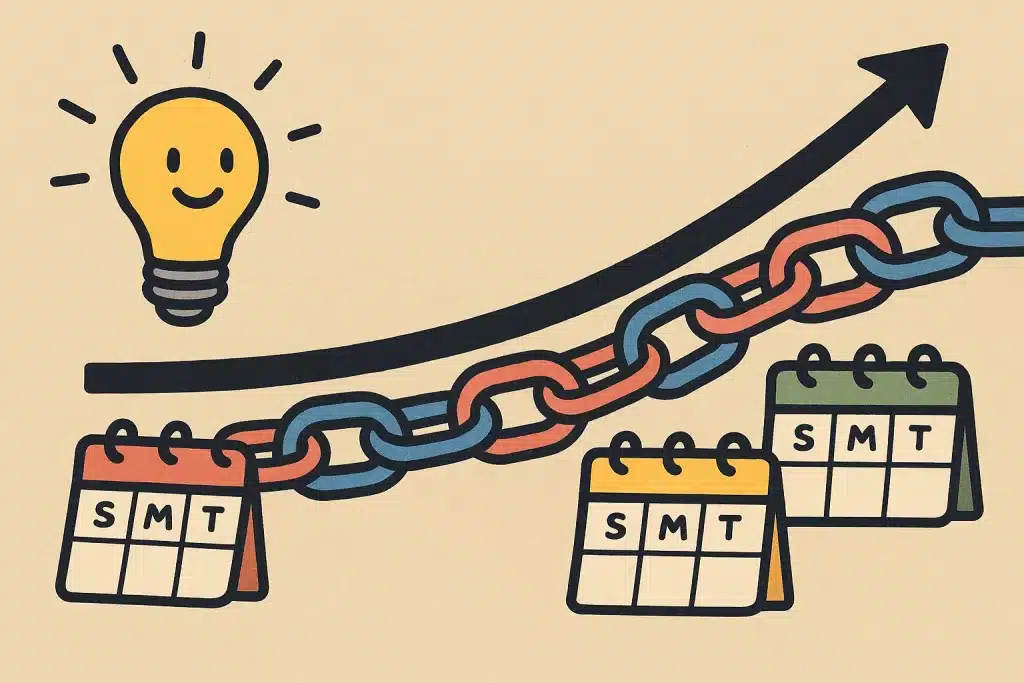In today’s fast-paced world, idea chains form over weeks, not days—a core insight for teams seeking real innovation—and it’s reshaping how modern creators, startups, and enterprises approach ideation.

Why “Idea Chains Form Over Weeks, Not Days” Matters
The phrase “idea chains form over weeks, not days” encapsulates a critical truth: meaningful, connected ideation—where concepts build on each other and evolve—requires time, patience, and structured incubation. In contrast to rushed “brainstorms,” innovation ecosystems and high‑performing teams are now turning toward processes that intentionally stretch over days or weeks.
The Science Behind Incubation: Insights from Academia
The Power of Unconscious Creative Processing
Research dating back to Dodds and Sio & Ormerod shows that incubation—letting ideas simmer subconsciously—yields higher‑quality creativity than forced, immediate idea generation.
Entrepreneurs’ Lived Process Over Time
A longitudinal study of founders in South Africa found that idea incubation involves cyclic, iterative phases—mobilizing, shaping, validating, refining—before crystallizing into viable venture concepts. These stages often span weeks, not hours.
Emerging Trend: Structured Incubation in Innovation Projects
Subheader: When Teams Adopt Slow-Burn Ideation, They Win
Innovators are increasingly building incubation phases into design sprints or workshops. As Nathan Baird recently wrote:
“Incubation is when you allow a problem to churn around below the threshold of consciousness, and the longer you incubate the greater the quality and number of ideas you’ll have.”
This trend is gaining traction among agencies and startups using generative AI, where teams break early workshops, circulate insights, then return later to build richer, interconnected idea chains.
Why Weeks, Not Days? Key Reasons
- Depth & Connectivity
Short, single‑day brainstorming often yields disjointed ideas. Extending ideation over weeks allows chains to link: early concepts inspire later ones, building depth. - Cognitive Incubation
Letting your mind mull ideas unconsciously—while multitasking or resting—activates remote associations. This fosters unexpected connections. - Feedback Loops
Over days, teams can share partial ideas, test relevance, and refine. This iterative loop builds chain structure in ideation. - Data‑Driven Tools & AI Augmentation
Modern AI tools are enabling “idea chaining”: tracking related notes, clustering themes, suggesting extensions over time. Early research shows GenAI systems accelerate idea diversity while still benefiting from incubation over multiple sessions.
How to Build an Idea Chain That Evolves Over Weeks
If you want to ensure idea chains form effectively over weeks, not days, here’s a practical guide:
1. Define a Problem Brief Early
Provide team members with a short brief or prompt—one sentence or a “How might we…” question. Circulate it days ahead of ideation sessions.
2. Separate Ideation into Multi‑Stage Workshops
- Stage 1 (Week 0): Kickoff & research
- Stage 2 (Week 0–1): Allow incubation; encourage private thinking
- Stage 3 (Week 1): Group ideation via hybrid session
- Stage 4 (Week 1–2): Iterate and refine with feedback
3. Encourage Solo Reflection & Cross-Pollination
Between sessions, participants can add ideas asynchronously in shared tools (e.g. Notion, Milanote). These asynchronous seeds help ideas link later.
4. Use Tools to Map Chains Explicitly
Create visual “ideation maps” that track how one idea led to another—like nodes connected by concept links. Seeing chains emerge reinforces the process.
5. Revisit & Reframe Problems
After initial ideation, restate the problem or inject new constraints. This reframing often triggers new idea offshoots along the chain.
Case in Point: Innovation Ecosystems Embracing Slow Ideation
Large innovation teams—notably those at tech companies and incubators—are shifting to slower-paced processes. While agile methodology emphasizes fast cycles, innovation labs are embedding incubation layers between sprints to encourage idea maturation.
One MIT Sloan Review feature emphasizes that true reinvention—like Apple’s iPhone transformation—depends on long-term collaboration, supply‑chain coordination, and multi-step innovation paths, not rushed execution.
Likewise, business incubator programs in emerging markets show that building robust startup concepts requires weeks of mentorship, validation, and network leverage—not single intensive sessions.
Benefits of Letting Idea Chains Form Over Weeks
- Better idea quality and originality
- Higher coherence across concepts
- Increased buy‑in from participants—they see own contributions evolve
- Stronger alignment with market needs through staged validation
How Generative AI Supercharges Multi‑Session Ideation
GenAI tools are increasingly layered into this process:
- They log early ideas, then later suggest linkages or novel directions.
- Teams using AI‑augmented ideation generate more diverse and higher‑quality concepts in less time—a trend confirmed by experiments in innovation management.
Yet even with AI speeds, incubation over days or weeks remains key: it ensures the AI suggestions build coherent chains, not isolated bullets.
Sample Innovation Flow: Weeks‑Long Idea Chain in Action
Week 0 (Monday): Issue creative brief → participants receive summary insights
Week 0–1: Teams incubate privately; capture early thoughts in shared doc
Week 1 (Monday): Group ideation workshop; cluster ideas, map relations
Week 1–2: Peer feedback, expert review; refine best chains
Week 2 (End): Final pitching of refined idea chains; optional prototyping phase
This timeline repeats in cycles, each time layering deeper connections and higher maturity.
Final Thoughts: Transforming Creativity Culture
In an era chasing instant results, the idea that innovation takes weeks, not days, feels counterintuitive. Yet, this patient approach unlocks true creativity. Teams that prioritize time, structure, and reflection produce stronger, interconnected ideas with real impact and scalability.
Innovation isn’t a single brainstorm—it’s a chain reaction built over stages. Foster a culture that values risk-taking and iteration, using tools like idea journals or collaborative check-ins. Leadership must champion this mindset, prioritizing depth over speed.
Embrace the slow burn of creativity. With thoughtful processes, your team’s ideas can evolve into transformative solutions.
References
1. Gabora, L. (2013). Cognitive Mechanisms Underlying the Creative Process. arXiv preprint.
JAMA Networkgpsych.bmj.com
2. Krings, G., Karsai, M., Bernharsson, S., Blondel, V. D., & Saramäki, J. (2012). Effects of time window size and placement on the structure of aggregated networks. arXiv preprint.
arXiv.
3. Cao, Y., Dong, Y., Kim, M., MacLaren, N. G., Pandey, S., Dionne, S. D., Yammarino, F. J., & Sayama, H. (2021). Visualizing Collective Idea Generation and Innovation Processes in Social Networks. arXiv preprint. Network






